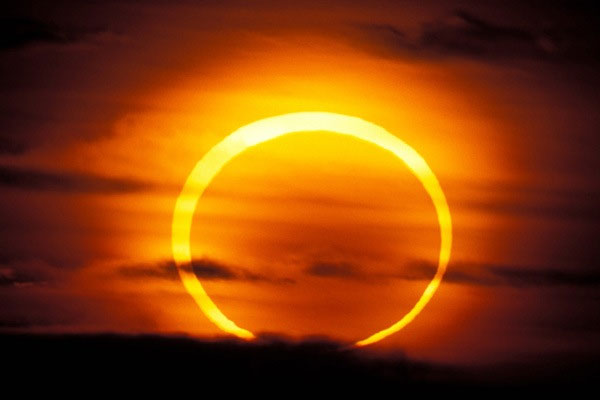A guide to observing the solar eclipse of the day on May 21
The annular eclipse with 94.39% coverage will be observed in a narrow strip of 240 to 300km width extending from the east coast of China to southern Japan, across the Pacific Ocean and ending in the western region of the United States. The observation point is the maximum eclipse located on the Pacific Ocean.
>>>China-Japan-America will witness a solar eclipse
The eclipse is partly observed in a larger area including East Asia, Southeast Asia, the Pacific and West America.
In Hanoi time, partial eclipse begins at 03:56:07 (hour: minute: seconds), the whole starts at 05:06:17, the maximum at 06:53:54, the total eclipse ends Ending at 08:39:11, eclipse partially ends at 09:49:21
In Vietnam, only a solar eclipse can be observed in the early morning at sunrise. Most locations in the territory of Vietnam observed the maximum of a solar eclipse at a time when the Sun began to grow at the eastern horizon standing at that location. However, it should be noted that due to many reasons such as restricting visibility, obscuring the horizon, unfavorable weather . so it is very difficult to observe the solar eclipse when the Sun rises as calculated but only close when the Sun has risen slightly.

Vietnam can only observe a solar eclipse in the early morning at sunrise.
Interestingly, this time the solar eclipse occurred at dawn, so we will see the sun is red and quite calm because the light is mostly absorbed by the atmosphere. Also, due to the visual trick illusion we will also see that the Sun is bigger than when it is on the top of the head. Therefore, even in the moment when the Sun rises and the light is still soft, we can measure eclipse with the naked eye.
However, soon after, we must use specialized filters, or traditional observation methods (such as using filters, welding glasses, projecting images of the Sun through telescopes or binoculars. white paper .) to admire partial eclipse, because at this time the light intensity of the Sun is also quite strong that can damage the retina.
Because solar eclipses occur in the early morning, it is difficult to use reflection method through mirrors placed in a water bath. In this case, to observe we have to use two mirrors (the first mirror is tilted under the ink bath, the second one works to direct the image of the Sun through the first mirror to the eye). .
Also because this solar eclipse happened early in the morning, we have to choose the open, open space to embrace the eastern horizon. In the city, we can choose the observation position on tall buildings.
On the territory of Vietnam in the mainland, Mong Cai is the place to observe the largest obscurity rate of 86.6% at 05:49:03, the partial eclipse ends at 06:14:20.
The islands in the East will observe a larger obscurity.
The eclipse recommended on May 21 is the first solar eclipse of 2012, the second solar eclipse is the total solar eclipse that occurred on November 13. This eclipse is only observed in the South Pacific. Northern Australians have the opportunity to observe the total solar eclipse. Partial bands will cover the southern Pacific and Antarctic.
A number of annular solar eclipse observations in our country
- Hanoi observed the maximum obstruction rate of 79.5% at 05:15:48, the partial eclipse ended at 06:13:27.
- Cao Bang observed the maximum obstruction rate of 85.4% at 05:12:42, the partial eclipse ended at 06:15:35.
- Da Nang observed the maximum obstruction rate of 67.3% at 05:15:06, eclipse partially ended at 06:07:35.
- Hue observed the maximum obstruction rate of 65.9% at 05:17:54, the eclipse partially ended at 06:08:09.
- TP. Ho Chi Minh observed a 32.5% maximum obstruction rate at 05:30:51, the partial eclipse ended at 06:01:11.
- Nha Trang observed a 51.5% maximum obscure rate at 05:17:51, eclipse partially ended at 06:02:35.- Tomorrow Vietnam will receive a solar eclipse
- Where is the best eclipse on March 9 in Vietnam?
- Rare real Japanese swept across 3 continents
- The Moon hides a black shadow on Earth when viewed from the universe
- Vietnam did not observe the first solar eclipse of the year
- Video: The coronary eclipse recommended in Australia
- When is the next solar eclipse in Vietnam?
- Reality and myths about solar eclipses
- Partial eclipse across North America
- Catch a partial solar eclipse on October 24
- Extremely rare eclipses happen this afternoon
- Video: The total solar eclipse may cause widespread power outages in the United States
 Van Allen's belt and evidence that the Apollo 11 mission to the Moon was myth
Van Allen's belt and evidence that the Apollo 11 mission to the Moon was myth The levels of civilization in the universe (Kardashev scale)
The levels of civilization in the universe (Kardashev scale) Today Mars, the sun and the Earth are aligned
Today Mars, the sun and the Earth are aligned The Amazon owner announced a secret plan to build a space base for thousands of people
The Amazon owner announced a secret plan to build a space base for thousands of people